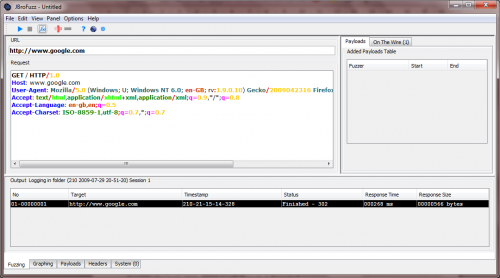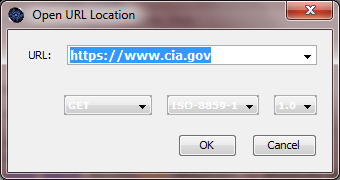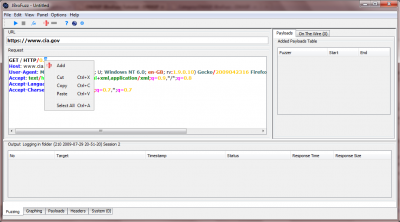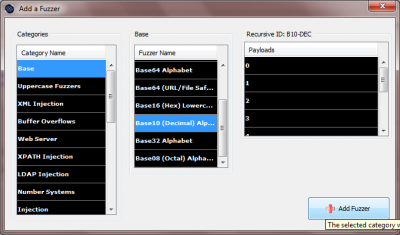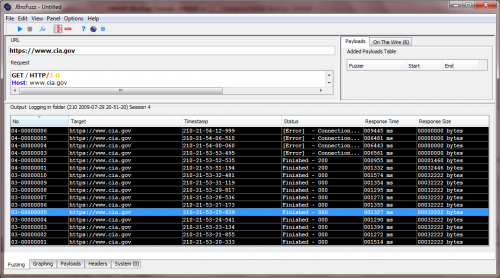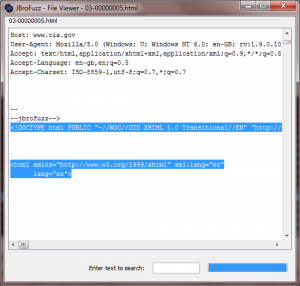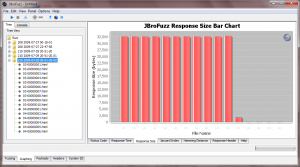This site is the archived OWASP Foundation Wiki and is no longer accepting Account Requests.
To view the new OWASP Foundation website, please visit https://owasp.org
Difference between revisions of "OWASP JBroFuzz Tutorial"
m |
m |
||
| Line 290: | Line 290: | ||
Thus the above scenario would iterate through all the digits from 0000 to ffff. I wouldn't recommend using the above scenario for such trivial fuzzing capabilities; simply presented as an example of the inner workings of JBroFuzz.jar | Thus the above scenario would iterate through all the digits from 0000 to ffff. I wouldn't recommend using the above scenario for such trivial fuzzing capabilities; simply presented as an example of the inner workings of JBroFuzz.jar | ||
| + | |||
| + | A more detailed code breakdown of the above HelloFuzzer example can be found below: | ||
| + | |||
| + | <pre> | ||
| + | /** | ||
| + | * JBroFuzz API Examples 01 | ||
| + | * | ||
| + | * JBroFuzz - A stateless network protocol fuzzer for web applications. | ||
| + | * | ||
| + | * Copyright (C) 2007, 2008, 2009 [email protected] | ||
| + | * | ||
| + | * This file is part of the JBroFuzz API examples on how to use the | ||
| + | * fuzzer libraries included in JBroFuzz.jar. | ||
| + | * | ||
| + | * JBroFuzz is free software: you can redistribute it and/or modify | ||
| + | * it under the terms of the GNU General Public License as published by | ||
| + | * the Free Software Foundation, either version 3 of the License, or | ||
| + | * (at your option) any later version. | ||
| + | * | ||
| + | * JBroFuzz is distributed in the hope that it will be useful, | ||
| + | * but WITHOUT ANY WARRANTY; without even the implied warranty of | ||
| + | * MERCHANTABILITY or FITNESS FOR A PARTICULAR PURPOSE. See the | ||
| + | * GNU General Public License for more details. | ||
| + | * | ||
| + | * You should have received a copy of the GNU General Public License | ||
| + | * along with JBroFuzz. If not, see <http://www.gnu.org/licenses/>. | ||
| + | * Alternatively, write to the Free Software Foundation, Inc., 51 | ||
| + | * Franklin Street, Fifth Floor, Boston, MA 02110-1301, USA. | ||
| + | * | ||
| + | * Verbatim copying and distribution of this entire program file is | ||
| + | * permitted in any medium without royalty provided this notice | ||
| + | * is preserved. | ||
| + | * | ||
| + | */ | ||
| + | |||
| + | import org.owasp.jbrofuzz.core.NoSuchFuzzerException; | ||
| + | import org.owasp.jbrofuzz.core.Database; | ||
| + | import org.owasp.jbrofuzz.core.Fuzzer; | ||
| + | |||
| + | /** | ||
| + | * <p>In JBroFuzz a Fuzzer is a java Iterator.</p> | ||
| + | * | ||
| + | * <p>In order to create a Fuzzer, use the factory method | ||
| + | * Database.createFuzzer(String, int), passing as arguments | ||
| + | * the Fuzzer ID and the specified length as a positive int.</p> | ||
| + | * | ||
| + | * <p>Be careful to check that the fuzzer ID (labelled as f_ID) | ||
| + | * is actually an existing ID from the Database of Fuzzers.</p> | ||
| + | * | ||
| + | * <p>Expected Output:</p> | ||
| + | * <code> | ||
| + | * The fuzzer payload is: 00000<br> | ||
| + | * The fuzzer payload is: 00001<br> | ||
| + | * ...<br> | ||
| + | * (a total of 16^5 = 1048576 lines)<br> | ||
| + | * ...<br> | ||
| + | * The fuzzer payload is: ffffd<br> | ||
| + | * The fuzzer payload is: ffffe<br> | ||
| + | * The fuzzer payload is: fffff<br> | ||
| + | * </code> | ||
| + | * | ||
| + | * <p>For more information on the Database of Fuzzers, see the | ||
| + | * HelloDatabase Class.</p> | ||
| + | * | ||
| + | * @author [email protected] | ||
| + | * @version n/a | ||
| + | */ | ||
| + | public class HelloFuzzer { | ||
| + | |||
| + | /** | ||
| + | * @param args | ||
| + | */ | ||
| + | public static void main(String[] args) { | ||
| + | |||
| + | // You have to construct an instance of the fuzzers database | ||
| + | Database fuzzDB = new Database(); | ||
| + | // You have to supply a valid fuzzer ID | ||
| + | String f_ID = "NUM-HEX-LOW"; | ||
| + | // You have to supply a (+)tive int | ||
| + | int f_len = 5; | ||
| + | |||
| + | try { | ||
| + | |||
| + | for(Fuzzer f = fuzzDB.createFuzzer(f_ID, f_len); f.hasNext();) { | ||
| + | |||
| + | // Get the next payload value... | ||
| + | System.out.println(" The fuzzer payload is: " + f.next()); | ||
| + | |||
| + | } | ||
| + | |||
| + | } catch (NoSuchFuzzerException e) { | ||
| + | |||
| + | System.out.println("Could not find fuzzer " + e.getMessage()); | ||
| + | |||
| + | } | ||
| + | |||
| + | } | ||
| + | |||
| + | } | ||
| + | </pre> | ||
| + | |||
| + | Also, the second example below focuses on accessing the Database of Fuzzers. In JBroFuzz, all Fuzzers are stored in a Database object that you will be required to construct in order to access them. | ||
| + | |||
| + | <pre> | ||
| + | /** | ||
| + | * JBroFuzz API Examples 02 | ||
| + | * | ||
| + | * JBroFuzz - A stateless network protocol fuzzer for web applications. | ||
| + | * | ||
| + | * Copyright (C) 2007, 2008, 2009 [email protected] | ||
| + | * | ||
| + | * This file is part of the JBroFuzz API examples on how to use the | ||
| + | * fuzzer libraries included in JBroFuzz.jar. | ||
| + | * | ||
| + | * JBroFuzz is free software: you can redistribute it and/or modify | ||
| + | * it under the terms of the GNU General Public License as published by | ||
| + | * the Free Software Foundation, either version 3 of the License, or | ||
| + | * (at your option) any later version. | ||
| + | * | ||
| + | * JBroFuzz is distributed in the hope that it will be useful, | ||
| + | * but WITHOUT ANY WARRANTY; without even the implied warranty of | ||
| + | * MERCHANTABILITY or FITNESS FOR A PARTICULAR PURPOSE. See the | ||
| + | * GNU General Public License for more details. | ||
| + | * | ||
| + | * You should have received a copy of the GNU General Public License | ||
| + | * along with JBroFuzz. If not, see <http://www.gnu.org/licenses/>. | ||
| + | * Alternatively, write to the Free Software Foundation, Inc., 51 | ||
| + | * Franklin Street, Fifth Floor, Boston, MA 02110-1301, USA. | ||
| + | * | ||
| + | * Verbatim copying and distribution of this entire program file is | ||
| + | * permitted in any medium without royalty provided this notice | ||
| + | * is preserved. | ||
| + | * | ||
| + | */ | ||
| + | |||
| + | import org.owasp.jbrofuzz.core.NoSuchFuzzerException; | ||
| + | import org.owasp.jbrofuzz.core.Database; | ||
| + | import org.owasp.jbrofuzz.core.Fuzzer; | ||
| + | |||
| + | /** | ||
| + | * <p>In JBroFuzz all Fuzzers are stored in a Database | ||
| + | * object that you will be required to construct in order | ||
| + | * to access them.</p> | ||
| + | * | ||
| + | * <p>Within the Database, each Fuzzer is a collection of | ||
| + | * payloads, which carries a unique ID string value.</p> | ||
| + | * | ||
| + | * <p>Example ID values are the output of this program:</p> | ||
| + | * <code> | ||
| + | * The fuzzer ID is: LDP-INJ<br> | ||
| + | * The name of the fuzzer is: LDAP Injection<br> | ||
| + | * The id of the fuzzer is: LDP-INJ<br> | ||
| + | * The of payloads it carries (it's alphabet) is: 20<br> | ||
| + | * It has as 1st payload:<br> | ||
| + | * |<br> | ||
| + | * The fuzzer ID is: XSS-IE4-567<br> | ||
| + | * The name of the fuzzer is: XSS IE<br> | ||
| + | * The id of the fuzzer is: XSS-IE4-567<br> | ||
| + | * The of payloads it carries (it's alphabet) is: 38<br> | ||
| + | * It has as 1st payload:<br> | ||
| + | * < img src=`x` onrerror= ` ;; alert(1) ` /><br> | ||
| + | * | ||
| + | * </code> | ||
| + | * | ||
| + | * <p>Do not be confused between Prototypes and Fuzzers; | ||
| + | * JBroFuzz uses Prototype objects to construct the Fuzzers | ||
| + | * that get added into the Database upon initialisation.</p> | ||
| + | * | ||
| + | * <p>As a result, the getter methods available within a Database | ||
| + | * object can carry the name of getAllPrototypeIDs and | ||
| + | * getAllFuzzerIDs interchangebly.</p> | ||
| + | * | ||
| + | * @author [email protected] | ||
| + | * @version n/a | ||
| + | */ | ||
| + | public class HelloDatabase { | ||
| + | |||
| + | /** | ||
| + | * @param args | ||
| + | */ | ||
| + | public static void main(String[] args) { | ||
| + | |||
| + | // You have to construct an instance of the fuzzers database | ||
| + | Database fuzzDB = new Database(); | ||
| + | |||
| + | // Get a list of all the fuzzer IDs from the database | ||
| + | String[] fuzzer_IDs = fuzzDB.getAllPrototypeIDs(); | ||
| + | |||
| + | System.out.println("The fuzzer IDs found are:"); | ||
| + | |||
| + | for(String fuzzerID : fuzzer_IDs) { | ||
| + | |||
| + | System.out.println("The fuzzer ID is: " + fuzzerID); | ||
| + | |||
| + | // We pass of length of 1, irrelevant if we are | ||
| + | // just going to access the first payload | ||
| + | // of the fuzzer | ||
| + | Fuzzer fuzzer; | ||
| + | try { | ||
| + | |||
| + | fuzzer = fuzzDB.createFuzzer(fuzzerID, 1); | ||
| + | // Normally you should check for fuzzer.hasNext() | ||
| + | String payload = fuzzer.next(); | ||
| + | |||
| + | System.out.println("\tThe name of the fuzzer is:\t\t\t" + fuzzer.getName() ); | ||
| + | System.out.println("\tThe id of the fuzzer is:\t\t\t" + fuzzer.getId() ); | ||
| + | System.out.println("\tThe of payloads it carries (it's alphabet) is:\t" + fuzzDB.getSize(fuzzerID)); | ||
| + | System.out.println("\tIt has as 1st payload:\n\t\t" + payload ); | ||
| + | |||
| + | } catch (NoSuchFuzzerException e) { | ||
| + | System.out.println("Could not find the specified fuzzer!"); | ||
| + | System.out.println("Going to print all the fuzzer IDs I know:"); | ||
| + | // old vs new for loop :) | ||
| + | // in case of an error, print just the | ||
| + | // fuzzer IDs, accessed from the DB | ||
| + | for(int j = 0; j < fuzzer_IDs.length; j++) { | ||
| + | System.out.println("The fuzzer ID is: " + fuzzer_IDs[j]); | ||
| + | } | ||
| + | |||
| + | } | ||
| + | |||
| + | } | ||
| + | |||
| + | } | ||
| + | |||
| + | } | ||
| + | </pre> | ||
| + | |||
| + | A final example of this section, involves seeing the usage of all the method calls available in the Fuzzer.java class | ||
| + | |||
| + | <pre> | ||
| + | /** | ||
| + | * JBroFuzz API Examples 03 | ||
| + | * | ||
| + | * JBroFuzz - A stateless network protocol fuzzer for web applications. | ||
| + | * | ||
| + | * Copyright (C) 2007, 2008, 2009 [email protected] | ||
| + | * | ||
| + | * This file is part of the JBroFuzz API examples on how to use the | ||
| + | * fuzzer libraries included in JBroFuzz.jar. | ||
| + | * | ||
| + | * JBroFuzz is free software: you can redistribute it and/or modify | ||
| + | * it under the terms of the GNU General Public License as published by | ||
| + | * the Free Software Foundation, either version 3 of the License, or | ||
| + | * (at your option) any later version. | ||
| + | * | ||
| + | * JBroFuzz is distributed in the hope that it will be useful, | ||
| + | * but WITHOUT ANY WARRANTY; without even the implied warranty of | ||
| + | * MERCHANTABILITY or FITNESS FOR A PARTICULAR PURPOSE. See the | ||
| + | * GNU General Public License for more details. | ||
| + | * | ||
| + | * You should have received a copy of the GNU General Public License | ||
| + | * along with JBroFuzz. If not, see <http://www.gnu.org/licenses/>. | ||
| + | * Alternatively, write to the Free Software Foundation, Inc., 51 | ||
| + | * Franklin Street, Fifth Floor, Boston, MA 02110-1301, USA. | ||
| + | * | ||
| + | * Verbatim copying and distribution of this entire program file is | ||
| + | * permitted in any medium without royalty provided this notice | ||
| + | * is preserved. | ||
| + | * | ||
| + | */ | ||
| + | |||
| + | import org.owasp.jbrofuzz.core.NoSuchFuzzerException; | ||
| + | import org.owasp.jbrofuzz.core.Database; | ||
| + | import org.owasp.jbrofuzz.core.Fuzzer; | ||
| + | |||
| + | /** | ||
| + | * <p>Example iterating through all the methods available | ||
| + | * in the Fuzzer Object and their respective outputs.</p> | ||
| + | * | ||
| + | * @author [email protected] | ||
| + | * @version n/a | ||
| + | */ | ||
| + | public class IndigoFuzzerTests { | ||
| + | |||
| + | /** | ||
| + | * @param args | ||
| + | */ | ||
| + | public static void main(String[] args) { | ||
| + | |||
| + | // You have to construct an instance of the fuzzers database | ||
| + | Database fuzzDB = new Database(); | ||
| + | // You have to supply a valid fuzzer ID | ||
| + | String f_ID = "NUM-HEX-LOW"; | ||
| + | // You have to supply a (+)tive int | ||
| + | int f_len = 5; | ||
| + | |||
| + | try { | ||
| + | |||
| + | Fuzzer f = fuzzDB.createFuzzer(f_ID, f_len); | ||
| + | |||
| + | while(f.hasNext()) { | ||
| + | |||
| + | // Could do this via reflection, but.. | ||
| + | f.next(); | ||
| + | // System.out.println(" The fuzzer payload is: " + f.next()); | ||
| + | System.out.println(" The maximum value is: " + f.getMaximumValue()); | ||
| + | |||
| + | System.out.println(" The current value is: " + f.getCurrectValue()); | ||
| + | |||
| + | |||
| + | |||
| + | } | ||
| + | |||
| + | |||
| + | } catch (NoSuchFuzzerException e) { | ||
| + | |||
| + | System.out.println("Could not find fuzzer " + e.getMessage()); | ||
| + | |||
| + | } | ||
| + | |||
| + | } | ||
| + | |||
| + | } | ||
| + | </pre> | ||
Revision as of 16:29, 30 July 2009
JBroFuzz Tutorial
Introduction
“If you can’t fuzz with JBroFuzz, you probably do not want to fuzz!”
The art of teaching, Mark Van Doren said, is the art of assisting discovery. Fuzzing is a representative discipline towards assisting the discovery of security vulnerabilities, that is just beginning to come of age. Over the last two years, through continuous development, JBroFuzz has attempted to expose the intrinsic beauty of the subject: Constantly submit a vast amount of payloads to a service, device or prompt, waiting for the one response that makes all the difference. This is the mentality that JBroFuzz embraces and attempts to offer back to security professionals.
Fuzzing as a concept goes beyond a conventional work flow or a standard methodology. I would argue that to know how to fuzz well, is to master a new language. Thus, similar to the process of learning a programming (or foreign) language, there are three things you must master:
• Grammar: How fuzzing as a process is structured
• Vocabulary: How to name fuzzing concepts you want to use
• Usage: Ways of achieving everyday effective results with fuzzing
There are a number of working examples described here within, which grep for statements such as “public static void main(String[] args)”. The majority of the content relates to reviewing these examples and putting the Java syntax into a fuzzing perspective.
To summarise, this tutorial focuses on customary and effective usage of fuzzing through the JBroFuzz Java APIs and the respective UI. It is targeting (without attacking them) web applications. Without further redo, let’s get fuzzing!
'Hello Google!' (forget 'Hello World')
As the traditional first program that you learn when indulging in a new programming language, 'Hello World!' represents the norm for understanding the basic output operations and syntax (let alone compiler and execution behaviour) of the language in question.
As with most web application security related tools, when I am given the responsibility to run them, often in order to understand how they work, I would first craft a legitimate, single request to a trusted (to be up and behaving) popular Internet location. Needless, to say this request more than on occasion finds itself on Google servers.
So 'Hello World!' for programming languages seems to transform to 'Hello Google!' for understanding how web application security related tools work. Let us see, how JBroFuzz does it.
• Double-click on JBroFuzz and browse to the 'Fuzzing' tab
JBroFuzz is constituted of tabs, typically located in the bottom or top (if you bother to change the settings) of the main window.
The 'Fuzzing' tab is where you craft your request message to a particular host. Once that is in place, you can select any part of the request and proceed into adding any number of payloads. We shall see how in later sections.
• In the 'URL' field type: http://www.google.com/ http://www.google.com
Unlike conventional URLs, the URL field in JBroFuzz is only used for the underlying protocol (HTTP or HTTPS), host name (e.g. www.yahoo.com) and (optionally) port number.
All remaining information pasted or typed into the 'URL' field will be ignored; you are expected to enter it in the 'Request' field below.
Still, if you want to just copy-paste a URL from a browser, hit [Ctrl+L] while you are not fuzzing, paste the URL value that you have copied from a browser and JBroFuzz will automatically do the work for you.
Examples of valid URL values to be put in the
Treat the 'URL' and 'Request' fields as the two stages of a 'telnet' session on port 80; you are effectively using the 'URL' field to specify the equivalent of:
>telnet www.google.com 8088
As equivalent to:
or in the case of HTTPS:
Naturally, default ports for HTTP is 80 and HTTPS is 443.
• In the 'Request' field type:
GET / HTTP/1.0
And press 'Enter' twice
This is where the body of the message you are sending is to be placed. So anything obeying HTTP/S protocol, such as GET and POST requests, header fields and/or HTML content should be included here.
As part of the process of fuzzing web applications with JBroFuzz you need to have done your homework, in terms of providing a base request message. This message is what will be used later on to add payloads to particular sections of the request.
• Hit 'Start' [Ctrl+Enter]
This will instigate the process of sending a single request to the specified host on a given (or default) port, over HTTP or HTTPS.
Once a connection has been established JBroFuzz will proceed to submit the message you have typed into the 'Request' field.
Finally, JBroFuzz will log all data sent and received into a file; accessing this file is typically a process of double clicking on the output line on the table at the bottom section of the 'Fuzzing' tab.
You should see a response received in the bottom part of the 'Fuzzing' panel. Double click (or right click for more options) to see the information exchanged; typically this would be a 302 redirect pointing you to another location. Congratulations, you have just said "Hello" to Google!
Now this would typically be enough under RFC rules, to get a response back; but damn all the bots out here, most websites require further information to respond back. So, in the 'Request' field let's pretend to be a (kind of) legitimate browser by typing:
GET / HTTP/1.0
Host: www.google.com
User-Agent: Mozilla/5.0 (Windows; U; Windows NT 6.0; en-GB; rv:1.9.0.10) Gecko/2009042316 Firefox/3.0.10 (.NET CLR 3.5.30729) JBroFuzz/1.5
Accept: text/html,application/xhtml+xml,application/xml;q=0.9,*/*;q=0.8Accept-Language: en-gb,en;q=0.5Accept-Charset: ISO-8859-1,utf-8;q=0.7,*;q=0.7
Not forgetting to end the request typed with two returns: Press 'Enter' twice. Again, you should be able to see a line added with the response received back.
Practice sending single requests to a website of your choice by changing the URL and also the 'Host:' field from the 'Request' above. Also try accessing an HTTPS website.
Alternatively, you can use the shortcut [Ctrl+L] to type in your URL, with the 'Request' field filled automatically, based on the URL you have typed.
HTTP Version Numbers & www.cia.gov Headerless Responses
For web applications, very often ill-defined requests submitted over the Internet, will trigger semi-legitimate responses that actually do not obey HTTP RFC protocol specification. Often, even though this is not the case in this example, these responses can lead to the identification of one or more security vulnerabilities.
In this example we test for the responses received for invalid HTTP version numbers on a particular website, namely www.cia.gov, over https. Now a word of caution here; please do not attempt to fuzz web applications that you do not have the authority to do so, especially over the Internet.
Still, for the purposes of this tutorial exercise, we will subject a web server to no more than a dozen or so requests. These requests would be otherwise identical, if it was not for the HTTP version number incrementing by a value of 1 on each request.
In terms of having the authority to do so, well this is identical to hitting 'Refresh' in your web browser a dozen or so times, while you are browsing to www.cia.gov. I do not consider this remotely close to any form of hacking, cracking, or proper fuzzing; web servers across the globe receive a lot more abuse than this on a daily basis.
Finally, by the time you are reading this, the particular issue described might have been fixed. So here goes:
• Within JBroFuzz, select:
File -> Open Location [Ctrl+L]
Type: https://www.cia.gov and hit enter. This is depicted in the following screenshot:
Hitting 'Enter' should automatically populate the 'URL' field and the 'Request' field within the 'Fuzzing' tab. What you see is the base request that we intend to add fuzzing payloads to. Before we do so, let us make one small alteration first:
• Modify the first line of the 'Request' field to:
GET / HTTP/0.0
Our objective is to enumerate the supported by the web server (in this case www.cia.gov) HTTP version numbers, following the two digit format that it has. We could be a lot more agressive here and test for buffer overflows and all types of injection; that would be out of line without the authority to do so. Instead we are going to see how JBroFuzz will iterate through the values of 0.0 to 1.4 by means of adding a Fuzzer to our base request.
• Highlight the second zero from the line 'GET / HTTP/0.0' and right-click, selecting 'Add'. This is depicted in the screeshot below:
• From the appearing 'Add a Fuzzer' window, select as 'Category Name', in the most left column 'Base' and as 'Fuzzer Name' in the middle column 'Base 10 (Decimal) Alphabet.
• Click on 'Add Fuzzer' on the bottom right of the window
This should add a Fuzzer of length 1 that iterates over the decimal (i.e. base 10) numbers 0 to 9. If we have added a hexadecimal Fuzzer instead of a decimal one (i.e. base 16) the iteration would from 0 to F. If we had selected two digits instead of one and proceeded to add a decimal Fuzzer, the iteration would be from:
00
01
..
98
99
From a User Interface (UI) perspective you should see a line added to the 'Added Payloads Table'.
• Click 'Start' [Ctrl+Enter]
This process will send 10 requests to the specified web server changing only first line of the request to:
GET / HTTP/0.0...
GET / HTTP/0.1...
...
GET / HTTP/0.8...
GET / HTTP/0.9...
While this is ongoing, you can sort the results by 'No' in the 'Output' table in the bottom of the 'Fuzzing' tab. This should enable you to see what request is currently being transmitted and received in real time.
Once complete, change the first line of the 'Request' field to read:
GET / HTTP/1.0
• Click 'Start' [Ctrl+Enter]
The resulting output should resemble the following screenshot:
Straight away we can notice a difference in the response size: For HTTP version numbers 0.0 to 0.9 we are getting back what seems fairly big in size responses; 32222 bytes in size worth of responses, given that HTTP protocol version 0.0 to 0.8 do not officially exist!
By double-clicking on one of these requests, we can see that the web server in question is responding back with no headers, yet returning a full HTML body; this represents the 32222 bytes of response of data we are receiving back. The following screenshot illustrates this:
Using the 'Graphing' tab we can proceed to graph the particular requests and responses for this given session.
• Within the 'Graphing' tab, click 'Start' [Ctrl+Enter].
• Select the directory corresponding to the Output folder we have used for this fuzzing session. This will typically be the last one.
• Right-click and select 'Graph'
Once complete, browse to the 'Response Size' tab within the 'Graphing' tab, as illustrated in the screenshot below:
To re-iterate this does not present a security vulnerability in any shape or form; merely the fact that by manipulating HTTP version numbers as part of the request we transmit, we can impact the response that we get back. In this case, what changes is the non-existent header fields, with some HTML content being received back.
If I was to guess what is causing this, I would say that some sort of load balancing or content delivery is not happening as it should when non-existent version numbers are being transmitted.
How to Use JBroFuzz as a Fuzzing Library
Quite often what you need to do in terms of fuzzing, far exceeds the User Interface (UI) of JBroFuzz. For this reason, a set of core fuzzing APIs have been made available that can be used for more advanced fuzzing scenarios.
The JBroFuzz.jar standalone archive (made available with every release) carries a core fuzzing library that holds a number of key classes. These are located under:
org.owasp.jbrofuzz.core.*; -Database.java -Fuzzer.java -NoSuchFuzzerException.java -Prototype.java
The class of importance is Fuzzer.java. Within JBroFuzz a Fuzzer is an instance of a java Iterator. This implies that values can be accessed by simply calling the next() method once an object has been made available. Typically, a call to hasNext() should also be performed prior to avoid an exception being thrown.
A Fuzzer can be obtained from the factory method createFuzzer(String, int); available for every instance of the fuzzing Database. Ergo:
Database myDatabase = new Database();
Fuzzer myFuzzer = myDatabase.createFuzzer("FUZ-ZER-ID0", 5);
So how do I use the API? Here is a simple HelloFuzzer (file called HelloFuzzer.java) example:
import org.owasp.jbrofuzz.core.*;
public class HelloFuzzer {
public static void main(String[] args) {
Database fuzzDB = new Database();
try {
for(Fuzzer f = fuzzDB.createFuzzer("NUM-HEX-LOW", 4); f.hasNext();) {
// Get the next payload value...
System.out.println(" The fuzzer payload is: " + f.next());
}
} catch (NoSuchFuzzerException e) {
System.out.println("Could not find fuzzer " + e.getMessage());
}
}
} // HelloFuzzer.java OWASP JBroFuzz Example 1
A command of: javac -classpath JBroFuzz.jar HelloFuzzer.java should compile the above program on command line.
Within the JBroFuzz.jar file, there is a file called fuzzers.jbrofuzz that carries all the fuzzer definitions that you see in the UI payloads tab of JBroFuzz.
Fuzzers belong in categories (1 to many) and each fuzzer carries a set of payloads that define the alphabet of the fuzzer.
Also, you have replacive or recursive fuzzers, based on the OWASP testing guide v2. For example, the hexadecimal alphabet is fuzzer definition is:
R:NUM-HEX-LOW:Base16 (Hex) Lowercase:16 > Number Systems | Base | Recursive Fuzzers | Lowercase Fuzzers 0 1 2 3 4 5 6 7 8 9 a b c d e f
stealing from the file fuzzers.jbrofuzz.
There is very little preventing you from defining your own fuzzers within this file, by following the file format specified above. You can use the UI to see if they have been loaded successfully.
Further to recursive and replacive fuzzers you also have zero fuzzers (i.e. a zero fuzzer of 1000 will just transmit 1000 requests as they are, without adding any payloads) double fuzzers, cross product fuzzers, etc.
Notice the factory method Database.createFuzzer("NUM-HEX", 4) yielding: "I want a 4 digit recursive fuzzer (why because NUM-HEX is recursive in its definition, starts with R: instead of P:) of HEX digits."
Thus the above scenario would iterate through all the digits from 0000 to ffff. I wouldn't recommend using the above scenario for such trivial fuzzing capabilities; simply presented as an example of the inner workings of JBroFuzz.jar
A more detailed code breakdown of the above HelloFuzzer example can be found below:
/** * JBroFuzz API Examples 01 * * JBroFuzz - A stateless network protocol fuzzer for web applications. * * Copyright (C) 2007, 2008, 2009 [email protected] * * This file is part of the JBroFuzz API examples on how to use the * fuzzer libraries included in JBroFuzz.jar. * * JBroFuzz is free software: you can redistribute it and/or modify * it under the terms of the GNU General Public License as published by * the Free Software Foundation, either version 3 of the License, or * (at your option) any later version. * * JBroFuzz is distributed in the hope that it will be useful, * but WITHOUT ANY WARRANTY; without even the implied warranty of * MERCHANTABILITY or FITNESS FOR A PARTICULAR PURPOSE. See the * GNU General Public License for more details. * * You should have received a copy of the GNU General Public License * along with JBroFuzz. If not, see <http://www.gnu.org/licenses/>. * Alternatively, write to the Free Software Foundation, Inc., 51 * Franklin Street, Fifth Floor, Boston, MA 02110-1301, USA. * * Verbatim copying and distribution of this entire program file is * permitted in any medium without royalty provided this notice * is preserved. * */ import org.owasp.jbrofuzz.core.NoSuchFuzzerException; import org.owasp.jbrofuzz.core.Database; import org.owasp.jbrofuzz.core.Fuzzer; /** * <p>In JBroFuzz a Fuzzer is a java Iterator.</p> * * <p>In order to create a Fuzzer, use the factory method * Database.createFuzzer(String, int), passing as arguments * the Fuzzer ID and the specified length as a positive int.</p> * * <p>Be careful to check that the fuzzer ID (labelled as f_ID) * is actually an existing ID from the Database of Fuzzers.</p> * * <p>Expected Output:</p> * <code> * The fuzzer payload is: 00000<br> * The fuzzer payload is: 00001<br> * ...<br> * (a total of 16^5 = 1048576 lines)<br> * ...<br> * The fuzzer payload is: ffffd<br> * The fuzzer payload is: ffffe<br> * The fuzzer payload is: fffff<br> * </code> * * <p>For more information on the Database of Fuzzers, see the * HelloDatabase Class.</p> * * @author [email protected] * @version n/a */ public class HelloFuzzer { /** * @param args */ public static void main(String[] args) { // You have to construct an instance of the fuzzers database Database fuzzDB = new Database(); // You have to supply a valid fuzzer ID String f_ID = "NUM-HEX-LOW"; // You have to supply a (+)tive int int f_len = 5; try { for(Fuzzer f = fuzzDB.createFuzzer(f_ID, f_len); f.hasNext();) { // Get the next payload value... System.out.println(" The fuzzer payload is: " + f.next()); } } catch (NoSuchFuzzerException e) { System.out.println("Could not find fuzzer " + e.getMessage()); } } }
Also, the second example below focuses on accessing the Database of Fuzzers. In JBroFuzz, all Fuzzers are stored in a Database object that you will be required to construct in order to access them.
/** * JBroFuzz API Examples 02 * * JBroFuzz - A stateless network protocol fuzzer for web applications. * * Copyright (C) 2007, 2008, 2009 [email protected] * * This file is part of the JBroFuzz API examples on how to use the * fuzzer libraries included in JBroFuzz.jar. * * JBroFuzz is free software: you can redistribute it and/or modify * it under the terms of the GNU General Public License as published by * the Free Software Foundation, either version 3 of the License, or * (at your option) any later version. * * JBroFuzz is distributed in the hope that it will be useful, * but WITHOUT ANY WARRANTY; without even the implied warranty of * MERCHANTABILITY or FITNESS FOR A PARTICULAR PURPOSE. See the * GNU General Public License for more details. * * You should have received a copy of the GNU General Public License * along with JBroFuzz. If not, see <http://www.gnu.org/licenses/>. * Alternatively, write to the Free Software Foundation, Inc., 51 * Franklin Street, Fifth Floor, Boston, MA 02110-1301, USA. * * Verbatim copying and distribution of this entire program file is * permitted in any medium without royalty provided this notice * is preserved. * */ import org.owasp.jbrofuzz.core.NoSuchFuzzerException; import org.owasp.jbrofuzz.core.Database; import org.owasp.jbrofuzz.core.Fuzzer; /** * <p>In JBroFuzz all Fuzzers are stored in a Database * object that you will be required to construct in order * to access them.</p> * * <p>Within the Database, each Fuzzer is a collection of * payloads, which carries a unique ID string value.</p> * * <p>Example ID values are the output of this program:</p> * <code> * The fuzzer ID is: LDP-INJ<br> * The name of the fuzzer is: LDAP Injection<br> * The id of the fuzzer is: LDP-INJ<br> * The of payloads it carries (it's alphabet) is: 20<br> * It has as 1st payload:<br> * |<br> * The fuzzer ID is: XSS-IE4-567<br> * The name of the fuzzer is: XSS IE<br> * The id of the fuzzer is: XSS-IE4-567<br> * The of payloads it carries (it's alphabet) is: 38<br> * It has as 1st payload:<br> * < img src=`x` onrerror= ` ;; alert(1) ` /><br> * * </code> * * <p>Do not be confused between Prototypes and Fuzzers; * JBroFuzz uses Prototype objects to construct the Fuzzers * that get added into the Database upon initialisation.</p> * * <p>As a result, the getter methods available within a Database * object can carry the name of getAllPrototypeIDs and * getAllFuzzerIDs interchangebly.</p> * * @author [email protected] * @version n/a */ public class HelloDatabase { /** * @param args */ public static void main(String[] args) { // You have to construct an instance of the fuzzers database Database fuzzDB = new Database(); // Get a list of all the fuzzer IDs from the database String[] fuzzer_IDs = fuzzDB.getAllPrototypeIDs(); System.out.println("The fuzzer IDs found are:"); for(String fuzzerID : fuzzer_IDs) { System.out.println("The fuzzer ID is: " + fuzzerID); // We pass of length of 1, irrelevant if we are // just going to access the first payload // of the fuzzer Fuzzer fuzzer; try { fuzzer = fuzzDB.createFuzzer(fuzzerID, 1); // Normally you should check for fuzzer.hasNext() String payload = fuzzer.next(); System.out.println("\tThe name of the fuzzer is:\t\t\t" + fuzzer.getName() ); System.out.println("\tThe id of the fuzzer is:\t\t\t" + fuzzer.getId() ); System.out.println("\tThe of payloads it carries (it's alphabet) is:\t" + fuzzDB.getSize(fuzzerID)); System.out.println("\tIt has as 1st payload:\n\t\t" + payload ); } catch (NoSuchFuzzerException e) { System.out.println("Could not find the specified fuzzer!"); System.out.println("Going to print all the fuzzer IDs I know:"); // old vs new for loop :) // in case of an error, print just the // fuzzer IDs, accessed from the DB for(int j = 0; j < fuzzer_IDs.length; j++) { System.out.println("The fuzzer ID is: " + fuzzer_IDs[j]); } } } } }
A final example of this section, involves seeing the usage of all the method calls available in the Fuzzer.java class
/** * JBroFuzz API Examples 03 * * JBroFuzz - A stateless network protocol fuzzer for web applications. * * Copyright (C) 2007, 2008, 2009 [email protected] * * This file is part of the JBroFuzz API examples on how to use the * fuzzer libraries included in JBroFuzz.jar. * * JBroFuzz is free software: you can redistribute it and/or modify * it under the terms of the GNU General Public License as published by * the Free Software Foundation, either version 3 of the License, or * (at your option) any later version. * * JBroFuzz is distributed in the hope that it will be useful, * but WITHOUT ANY WARRANTY; without even the implied warranty of * MERCHANTABILITY or FITNESS FOR A PARTICULAR PURPOSE. See the * GNU General Public License for more details. * * You should have received a copy of the GNU General Public License * along with JBroFuzz. If not, see <http://www.gnu.org/licenses/>. * Alternatively, write to the Free Software Foundation, Inc., 51 * Franklin Street, Fifth Floor, Boston, MA 02110-1301, USA. * * Verbatim copying and distribution of this entire program file is * permitted in any medium without royalty provided this notice * is preserved. * */ import org.owasp.jbrofuzz.core.NoSuchFuzzerException; import org.owasp.jbrofuzz.core.Database; import org.owasp.jbrofuzz.core.Fuzzer; /** * <p>Example iterating through all the methods available * in the Fuzzer Object and their respective outputs.</p> * * @author [email protected] * @version n/a */ public class IndigoFuzzerTests { /** * @param args */ public static void main(String[] args) { // You have to construct an instance of the fuzzers database Database fuzzDB = new Database(); // You have to supply a valid fuzzer ID String f_ID = "NUM-HEX-LOW"; // You have to supply a (+)tive int int f_len = 5; try { Fuzzer f = fuzzDB.createFuzzer(f_ID, f_len); while(f.hasNext()) { // Could do this via reflection, but.. f.next(); // System.out.println(" The fuzzer payload is: " + f.next()); System.out.println(" The maximum value is: " + f.getMaximumValue()); System.out.println(" The current value is: " + f.getCurrectValue()); } } catch (NoSuchFuzzerException e) { System.out.println("Could not find fuzzer " + e.getMessage()); } } }

